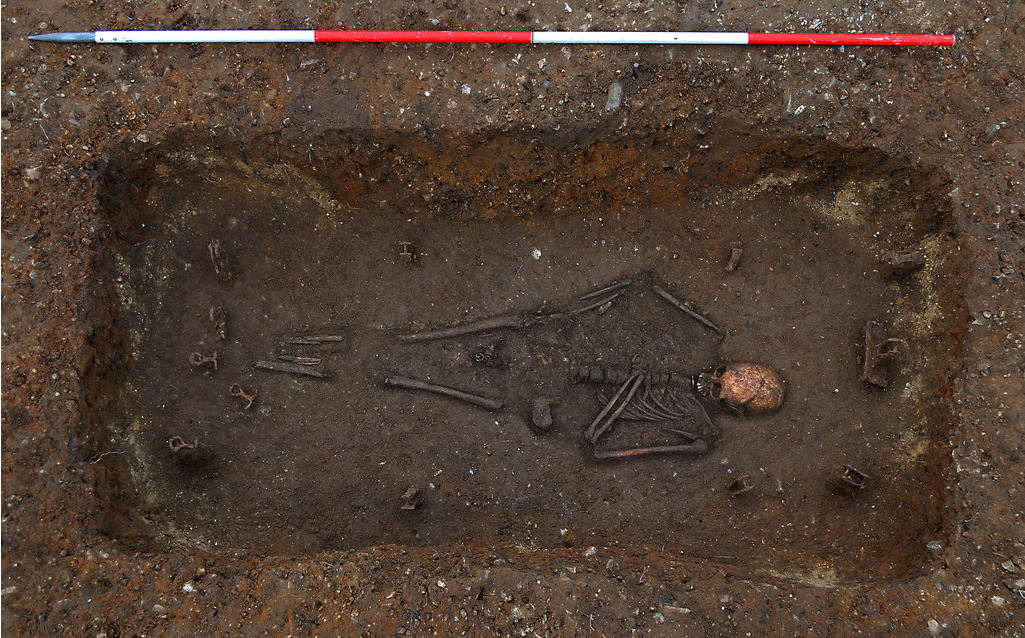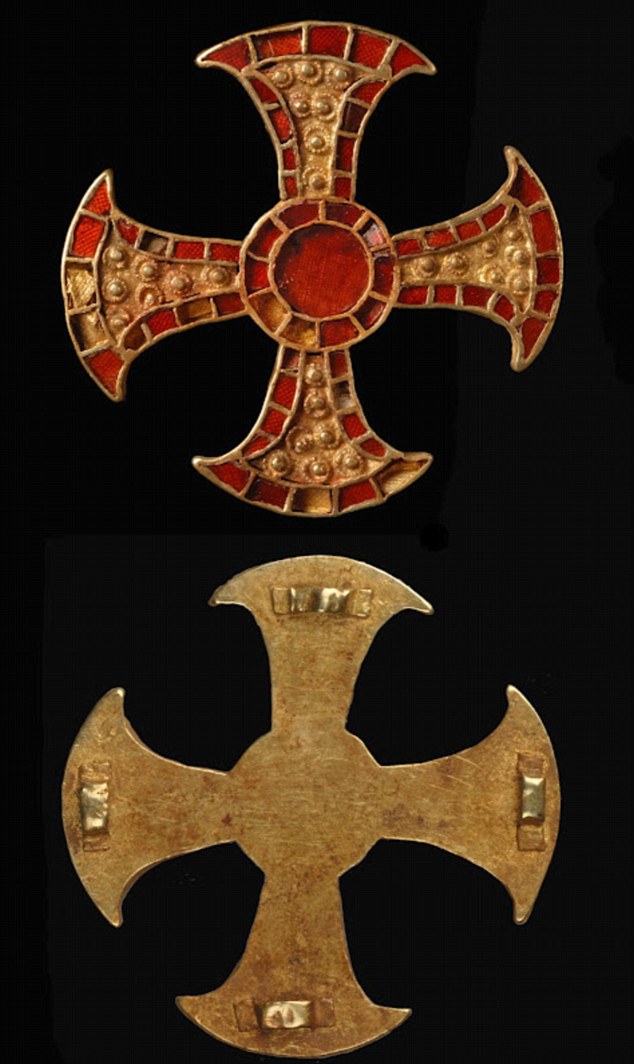Christian Significance of Burial
Bed Burials
Her Golden Cross
Conclusion
Wrap Up
References
Back To Top
Introduction
The native speakers of Old English known as the Anglo-Saxons are long gone. But, as with so much ancient history, they just can't help but be brought back into the present every now and then. As a recent article in the Hamilton Spectator reveals a new find in the field,1 now might just be the second most exciting time to be an Anglo-Saxonist or somebody just fascinated by old burials and treasure hoards.
The most recent Anglo-Saxon find is the burial of a teenage girl. What's so special about her burial? After all, many people were buried then as they are now. Especially since she's been pegged as living in the 600s, when Christianity was coming back to Britain. Riding this tangent out, what's Christianity got to do with a girl being buried?
Back To Top
Christian Significance of Burial
Cutting straight to the quick, burial is essential according to traditional Christian belief in the Final Judgment. For, it is at the time that Christ comes back that all the dead shall rise and have their sins and virtues weighed and the lambs and the goats will be separated and so on. But if your body was cremated (or burned on a boat set out to sea - I'm looking at you, Vikings), then your soul won't have anything to wear to the final judgment. Traditionally, nothing is said about bodies reconstituting themselves from ashes and then rising for the last judgment.
So this Anglo-Saxon teen would have been buried in accordance with the new faith of the land. What's peculiar about her case though, is what she was buried with, and what she was buried in.
She wasn't buried in a coffin, no, she was buried in a bed.
Back To Top
Bed Burials
Bed burials among the Anglo-Saxons seem to be quite rare. To date only 13 have been found.2
Nonetheless, these bed burials have a some things in common. Most involve women, many include jewelry that suggest a high social rank.2
Most interesting about this practice is the fact that the Old English word "leger" ("a place where one lies") could refer to either a bed or a grave.2 This crossing of the two ties in nicely with a lot of the enduring associations of sleep and death. Such things definitely go back to the time of Christ as he says "Our friend Lazarus sleepeth" when he is talking with Mary and Martha.3
But for the pagan Anglo-Saxons what might the connection between sleep and death mean? Sleep and death are visible in the seasons, certainly. The earth seems to sleep beneath blankets of snow in the winter when many plants die out, and then wakes again in spring.
Getting a bit more personal, sleep and death were also closely connected in pagan ideas of death. Similar to the Christian idea of the soul carrying on to another place upon the death of the body, Norse pagans believed that some part of the person journeyed to some form of the afterlife. The beliefs of the Anglo-Saxons may have differed from this, but certainly only slightly - especially as they would have been in close contact with the Norse throughout the 6 and 700s.4
The fact that the Anglo-Saxon word "leger" was used to signify both sleep and death during the 7th century also attests to Anglo-Saxon ideas of the two being connected. As the two are connected, though, what did the Anglo-Saxons think happened when people awoke from death? Or did they think that the afterlife was a dream had by the dead? These nuances of Anglo-Saxon belief are unclear, but when Christianity becomes widely adapted they must have either been completely consumed or maybe blended with the perspective of the new religion.
Back to the Ixworth teen and what she was buried with. As a young woman of power in a Christian nation, she was buried with what else upon her chest but a golden cross.
Back To Top
Her Golden Cross
The artistry of the girl's golden cross is incredibly fine. The mix of gold base and cut garnets is indeed striking. But, what does it mean?
The cloisonné style (art consisting of multiple cells) of it shows the intricacy that 7th century Anglo-Saxon artisans were capable of, but why gold and garnet?5
Gold has always been regarded as valuable, and indeed the Anglo-Saxons prized it among treasures. A quick read through the first part of Beowulf, where Heorot is described as a hall decked about with the stuff (on line 308) makes its value clear.6
Garnet on the other hand seems more obscure. If you allow there to be a connection between modern pagan practices and ancient ones, then the garnet stone seems to be most closely related to repelling evil and helping with blood flow.7 That such material be used for a cross, and one that was sewn onto the girl's clothes, no less, suggests that it may have been worn for spiritual protection. Perhaps as an aid against the temptations of the world. This works well with the current theory that this girl was associated with a nearby abbey - possibly even as the abbess herself.
Back To Top
Conclusion
So this find is a little bit removed from what's generally associated with Anglo-Saxons. There isn't a great treasure hoard here or a lot of ornate armour or weaponry. Instead, this teenage corpse sheds light on the more refined side of Anglo-Saxon culture. The side that's often lost amidst the images of wenching, ale-ing, and fighting, but that's no less important. For starters, it definitely civilizes the Anglo-Saxons to some degree. It shows that outside of their shield-play and bard-song they had some refinement.
Perhaps this other side's being revealed in this teenage girl's burial is due to a different set of values having been ascribed to women. Not necessarily by the Anglo-Saxons (let's not forget that there were some very powerful Anglo-Saxon women), but within the Christian system that was in place by this time.
In fact, given that garnet was a stone associated with protection, perhaps this young woman was as much a warrior as a male could have been. Only, rather than fighting on the field of grass and dust, hacking through bone and flesh with iron, she was fighting on the field of litanies and vespers, lunging at sin with paternosters.
Back To Top
Wrap Up
What's your favourite archaeological find of all time? Feel free to post about it in the comments.
And check back on Friday for an attempt to find some lasting good in the movie, Battlefield Earth.
Back To Top
References
1. Raphael Satter. "Archaeologists discover seventh-century teenager buried in bed." TheSpec.com. 16 March 2012.
2. "Bed Burial" Wikipedia. 20 March 2012.
3. Bible, The King James Version.
4. "Norse activity in the British Isles." Wikipedia. 8 March 2012.
5. "cloisonné." Merriam-Webster Dictionary Online. 2012.
6. Beowulf in Hypertext. McMaster University.
7. Cresentmoon2007. "Garnet and Its Magical Properties." HubPages. December 2011.
Back To Top



No comments:
Post a Comment